Decorative concrete fence: beautiful design options
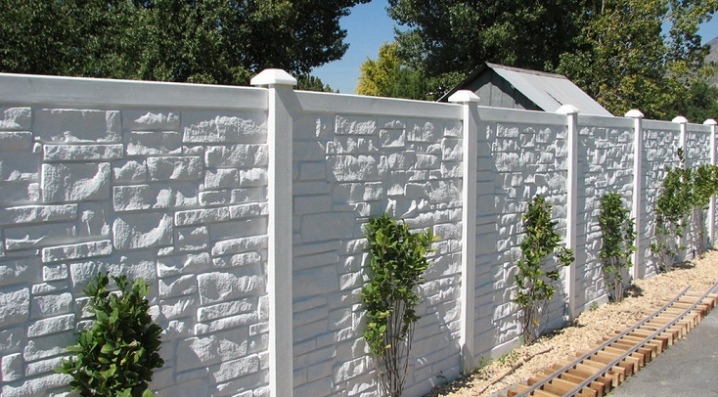
The choice of the fence and its installation are important components of the design of the land. The modern market provides buyers with a wide range of structures, including sectional types for reliable, practical and stylish zoning of the local area. Among the variety of such options, concrete fences are especially widespread.
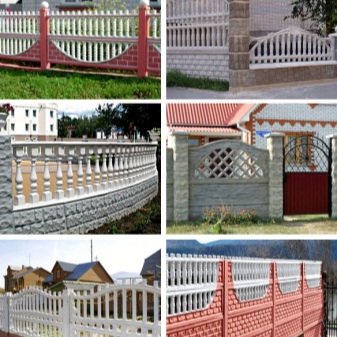
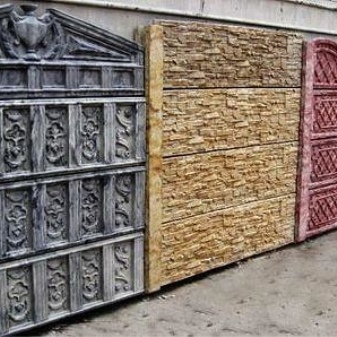
Features, pros and cons
Decorative concrete fences are used to decorate the territory near various objects: from residential buildings and summer cottages to government and commercial buildings. Concrete fencing is a reliable, durable and practical structure. These are the same products familiar to everyone, however, their main difference lies in a more aesthetic appearance and production technology. Craftsmen in the field of precast concrete products use certain forms, due to which austere panels are transformed into decorative products.
In addition to the appearance, special attention is paid to the strength of each part of the structure and its resistance to external factors during use. The concrete slab is assembled from horizontal parts.
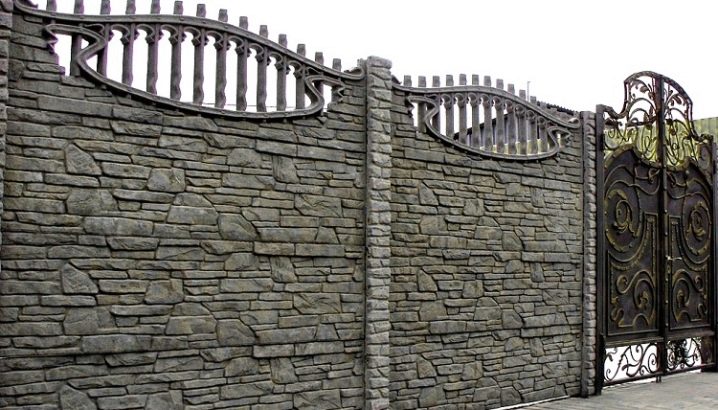
Due to the division into separate sections, the process of transporting the product, as well as installing the fence, is greatly facilitated. This is especially important if you decide to carry out the installation yourself, without the involvement of specialists.
Buyers have the opportunity to create both solid fences and models with holes and gaps from the sections. Today, concrete fences are the best option for decorating the territory around private houses.
Advantages:
- Service life and reliability. Reinforced concrete products (reinforced concrete products) are famous for their high practicality and durability. This material has been used for more than a dozen years. Due to the reinforcement of the fence with a metal mesh, the strength of the product increases. Also, this element significantly extends the service life of the fence and retains its shape.
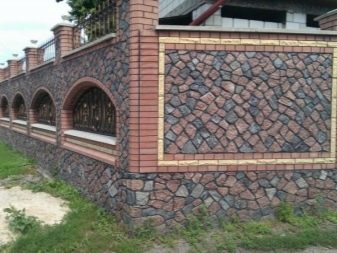
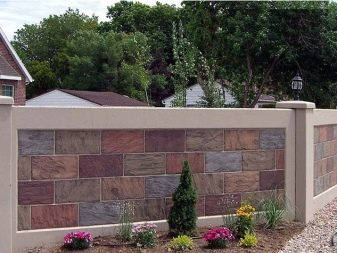
- Assembly and installation. The installation of concrete fences does not require expensive equipment and professional skills. You can carry out the assembly and subsequent installation qualitatively on your own. The main thing is to be as careful and accurate as possible in the process of work. It is strongly discouraged to work alone.
- Resistant to fire. Products made from the above material have an important advantage over fences made of wood or plastic. It is fire retardant. Fire safety is an important advantage of household structures.
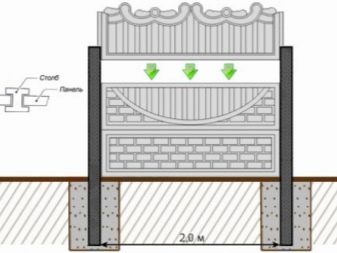
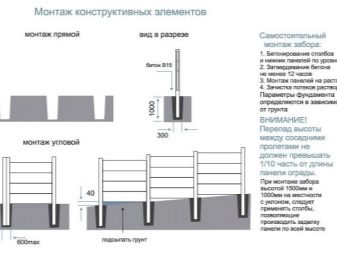
- Protection. Deaf canvases will easily hide the yard and the house from unwanted eyes. The fence will provide reliable protection against penetration. With such a fence, you don't have to worry about the safety of private property. Due to this, the level of comfort in the territory of the house and yard increases.
- Stability. Concrete demonstrates high resistance to various external factors: rain, snow, strong wind, frost, heat, dampness, dry hot air. All these and other vagaries of the weather are not terrible for well-made and correctly installed fences.
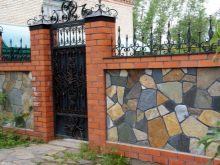

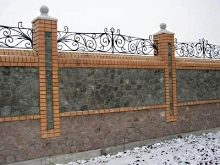
- Care. After installing a fence of this type, you do not have to spend effort, time and money on the maintenance of the structure. Caring for such products is as easy as shelling pears. Strong, robust and stable surface does not need periodic renewal.
- Diversity.Decorative concrete fences can have different looks. Experts say that, despite the strength and heavy weight, the designs look stylish and sophisticated due to expressive decorative elements. Such a fence will instantly embellish the exterior and make the yard more attractive.

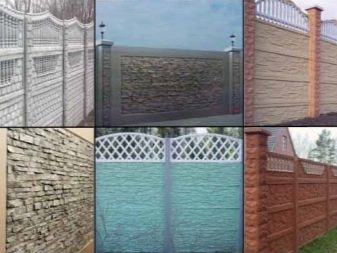
- Finishing. If desired, the fence can be decorated with paint, putty or plaster. These finishing materials perfectly fit the concrete product and transform the appearance of the fence. Enamel paint and other materials provide additional protection for the structure.
- Change in dimensions. One of the main features of concrete fences is the change in the height of the structure while maintaining the visual appeal of the product. Such an advantage is possessed by fences, which are assembled from separate parts fastened by pillars. Sections can be added and removed as needed. This procedure does not require additional equipment and takes little time.
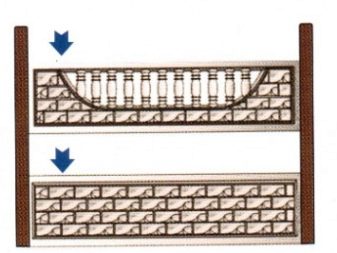
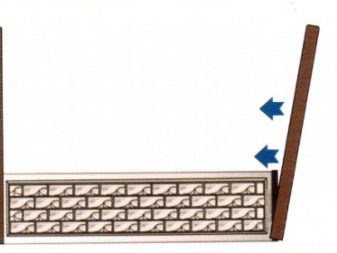
Disadvantages:
- Concrete blank walls keep out the sun's rays and fresh air. This factor negatively affects the growth process of plants (flowers, shrubs, trees). Light and oxygen enter only through the decorative part, if there are holes in it.
- The second disadvantage is the cost of reinforced concrete panels. Their price can be several times higher than the value of a product made of wood, corrugated board, metal and other materials.
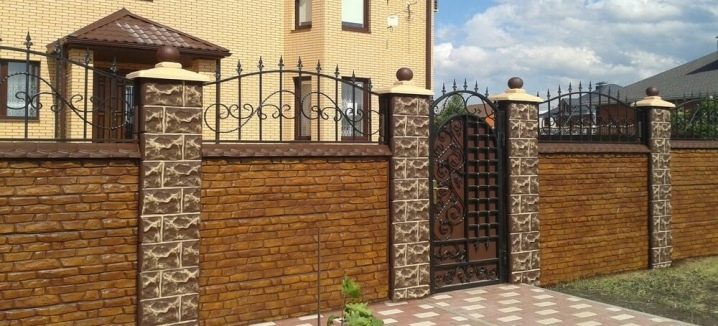
- To install a structure of this type, it is necessary to prepare the foundation. Experts distinguish two of its types: a point foundation and a tape reinforced concrete. The choice depends on the type of construction, height and weight of the product. In addition, the choice is influenced by the type of soil and landscape. If you do not know which option to choose, it is better to first consult with a specialist.
- If you are dealing with large and solid canvases, you cannot do without special lifting equipment, and this is an additional expense. It is almost impossible to assemble monolithic sections by hand. In addition, this method of installation can cause serious injury.
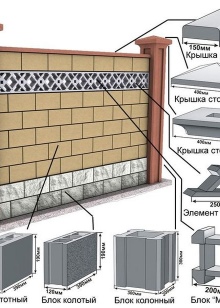
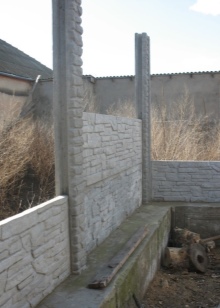
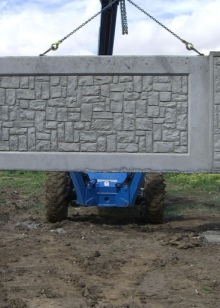
Installation options
Decorative concrete fences can be presented in several versions:
- If it is necessary to equip a small hedge solely for the zoning effect, only one decorative section can be installed. Such a fence will not protect against intruders, however, it will decorate the territory.
- A product of two sections is installed if it is necessary to protect the site from animals.
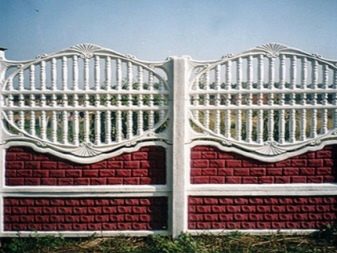
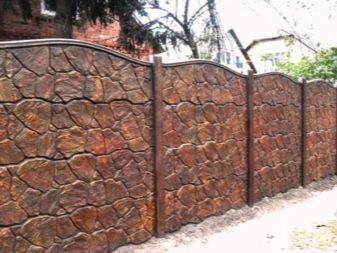
- The best option is 3 elements. Combine two solid and one decorative section. The upper part is decorated with various patterns and volumetric elements.
- Four-section construction - strong, high and heavy fence. To install it, you must first prepare the foundation, taking into account the dimensions of the fence.
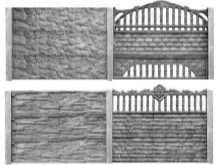
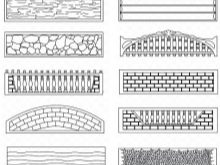
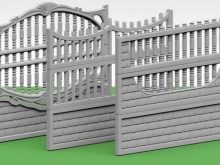
Blocks
Decorative blocks differ from each other in appearance and technical characteristics. In addition to concrete, which is the main component in the composition of the material, glass, gravel, crushed stone, brick chips, etc. are used.
By filling, decorative blocks are distinguished:
- Corpulent. They have a solid structure. They are often used in the construction of multi-storey residential structures.
- Hollow. This type of block is smooth and lightweight. They can have a variety of colors. The standard dimensions of the blocks are 200x200x400 mm, however, during the construction process, elements of various sizes can be used.

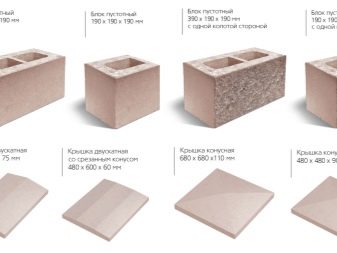
Concrete fences are often used to decorate sections of country houses. The upper part of the decorative block can imitate a natural material such as stone. The additions of metal gratings and masonry look stylish and sophisticated.
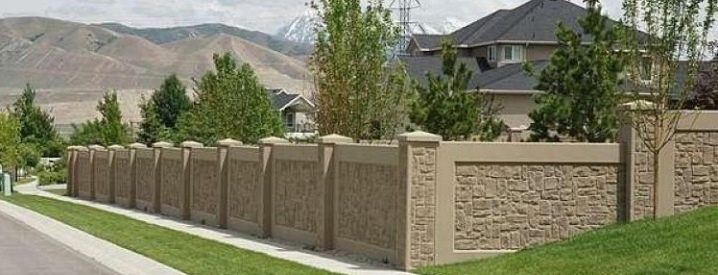
Tiles, forged elements, tops, caps and other additional elements are also actively used. They not only decorate the fence, but also protect it from snow, rain and other vagaries of the weather.
Varieties
There are many models of decorative concrete fences. Thanks to the huge selection, customers have the opportunity to purchase the ideal option for themselves:
- The stacked fence consists of several slabs assembled into a whole structure. The top of the hedge is complemented with an expressive decorative element that completes the composition. If desired, a small gap can be left between the plates, which will ensure air circulation. If you need to achieve the maximum effect of security, opt for blind canvases.
- For connoisseurs of natural materials, the craftsmen have developed a number of models that copy the appearance of natural raw materials. Also common options "brick".
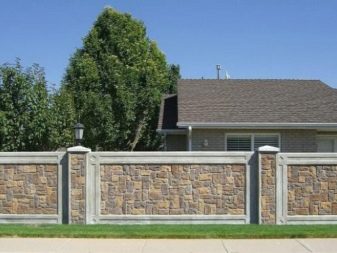
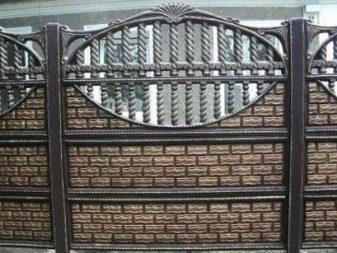
- Monolithic construction. The design of this type is the most reliable and durable. Monolithic fencing consists of one-piece reinforced concrete slabs. They can be smooth or decorated with exquisite patterns and designs. The first type is more often chosen for installation near industrial establishments (warehouses, factories, construction sites, etc.). The second option is great for accommodation near summer cottages, houses, mini-hotels. For a more expressive effect, patterned slabs are painted in various colors and shades.
For the installation of the fence, it is necessary to prepare a strip or columnar base. The right base is the key to a long service life.


- Block fence. A strong and durable fence can be assembled from several blocks. The process of installing block fencing takes a considerable amount of time. A cement mortar is used to connect the blocks. For work, hollow blocks are most often used. If the customer wants to achieve maximum reliability, the choice is made in favor of monolithic (solid) blocks. Support pillars are not needed for the arrangement, but you cannot do without a high-quality foundation.
To increase the aesthetic effect, decoration with plaster or tiled cladding is used. Externally, the finished structure is similar to brickwork.
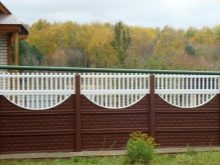
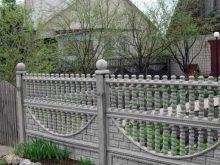
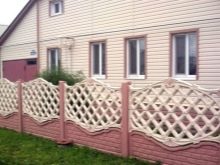
- Double-sided fence. This is a sturdy and reliable construction, which differs from the above types in its special attractiveness. Craftsmen pay special attention to the appearance of the outer and inner sides of the fence. This option will appeal to connoisseurs of aesthetics.
- Self-contained type. A fence of this type is made up of individual monolithic reinforced concrete slabs. Each element has a wide base that sits securely to the ground. For a more stable grip, the bottom of the plates is supplemented with spikes that are installed in specially prepared niches. The main advantage of a self-contained fence is that there is no need for a foundation.
This option is recommended for temporary fencing, for example, for decorating construction sites. When the work is over, the fence is moved to a new location.
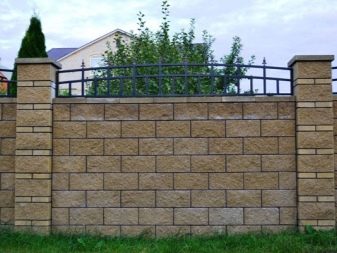
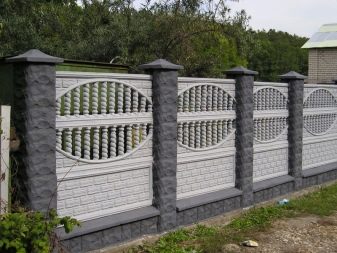
How to paint?
Enamel paints applied to concrete have many useful functions, including protecting the product and improving its appearance. It is very important to carry out the correct painting procedure for the product.
Preparation for staining:
- First, you need to rid the fence of branches, grass and other debris.
- Using a brush and water, thoroughly clean the surface. For the best effect, special devices are used that supply water under strong pressure.
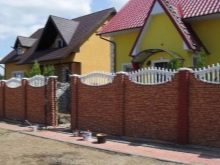
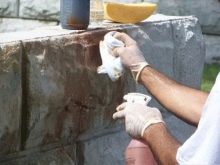
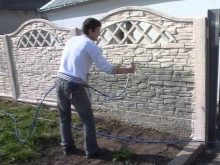
- We treat the fence with compounds that protect it from fungus, mold and bacterial growth. Additional agents are applied to both sides of the fence.
- If necessary, the structure should be primed.
- After cleaning, you need to wait a few days for the fence to dry completely.
When choosing a paint color, consider to blend in with the palette used when painting the house. The best option is neutral and natural colors, pastel colors.
You need to choose paint in natural shades if you used wood or stone imitation slabs when decorating the fence.

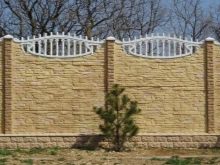
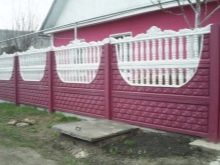
The paint should be applied with a roller or wide pussy. Before starting work, read the instructions for the material. It will take about a day to dry. Only then can the next layer be applied. Re-painting should be done with a spray gun. This is an easy-to-use and practical method that will extend the life of the material.
Tips from experts:
- If the fence has already been painted, it is necessary to completely get rid of the old finish. Sandblasting is perfect for this.
- Do not take the choice of paint color lightly. Saturation, brightness and hue density play an important role from a decorative point of view. The harmonious combination of colors creates a comfortable environment on the local area.
- Periodic processing of a concrete structure is the key to a long service life.
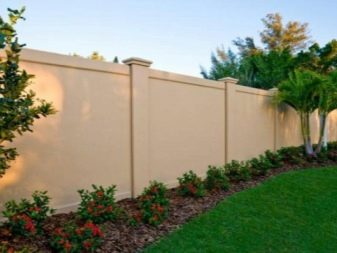
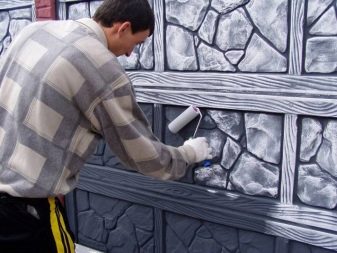
The Basics of Correct Installation
The installation of a concrete fence is a clear sequence of certain actions:
- To begin with, all parts of the structure, including the posts, must be moved as close as possible to the place of work. This will make the installation process easier and faster.
- Places for the installation of supports are pre-designated. They are marked with wooden pegs.
- If the model of the fence implies a foundation, time is first given to this item, and then the installation of the pillars is carried out. Otherwise, the supports are mounted without a columnar foundation.
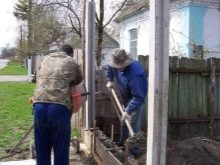
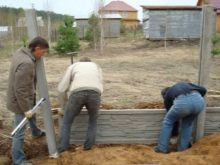

- Metal fittings are installed in the hollow parts of the supports and fixed with cement.
- At the very beginning, the first and last pillars are mounted. Next, intermediate sections are placed.
Remember that the preparation and installation of a concrete fence can vary significantly depending on the type of product and its dimensions.
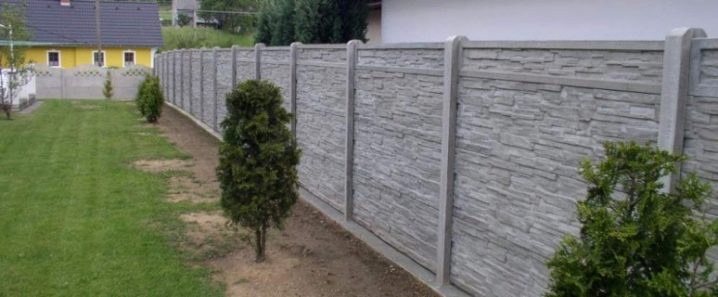
Today, many companies work in the field of manufacturing decorative concrete fences that have earned the trust of their customers. By purchasing products of this type, the buyer receives a reliable, practical, durable and stylish fence. The choice is large and varied, which allows you to choose the ideal design for external and technical characteristics.
For information on how to properly install a concrete fence, see the next video.



































































The comment was sent successfully.